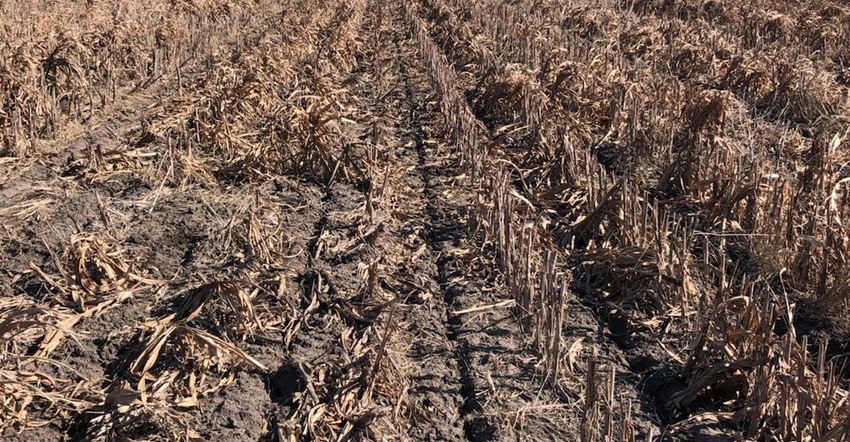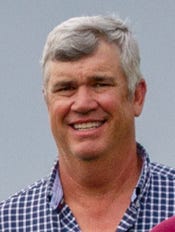
Reduced greenhouse emission isn't what originally motivated Texas Coastal Bend producers Jim Massey and Jon Whatley to reduce their tillage practices. Instead, the region's wind, drought, low humidity, and deteriorating soil health prompted the change.
But in a world committing to reducing harmful emissions, these producers' management practices may be about to pay dividends greater than soil health.
Whatley and Massey participated in a virtual producer panel discussing their conservation tillage practices with moderator and Texas A&M AgriLife Extension agent Jason Ott during the recent "Carbon Farming in Texas Workshop."
 Jim Massey (Photo by United Sorghum Checkoff Program)
Jim Massey (Photo by United Sorghum Checkoff Program)
Massey, who began farming with his father in Nueces County in 2000 and on his own in 2012, said reduced tillage was his dad's antidote for fighting sand. "That was part of his quest was to leave residue on top of the ground so we wouldn't be fighting sand as much," Massey said.
Whatley, who farms in San Patricio and Nueces counties, said he transitioned from conventional tillage to 100% strip-till because "I was a soil health guy. I was worried about what I was doing with my soil. I didn't understand why we were continuing to get rid of all our organic matter.
"I wasn't thinking greenhouse gases. I wasn't thinking of all the things we are thinking of today. I was trying to have a better place to put my seed and have everything that it needs right next to the plants and the roots."
Working backward
When Massey and his father began transitioning their conservation tillage practices, he said they started with maximum reduced tillage and worked their way backward.
See, Be patient on selling carbon credits
"We tried no-till and found it difficult to get a stand some years. Then we tried strip-till and had a few issues with that, one being the Pennsylvania pellitory, getting it under better control."
Today, through trial and error, Massey has settled on a system where he does between-the-rows subsoiling with a no-till subsoiler that doesn't disturb the topsoil. Then in the late winter, early spring, he makes one pass with a Turbo-Max, a vertical-till coulter rig, that levels out the soil.
"It leaves the ground in a condition that looks like what a field cultivator would do, but it can go through a whole lot of residue," he explained, "and then we plant."
Massey doesn't recommend going full no-till and working backwards. "It's risky," Massey said. "It's better to start with something less ambitious, something you're more comfortable with and work into it. Maybe start with one field."
No-till doesn't fit
Whatley is 100% strip-till. "I tried a little bit of the no-till and found that cropping rotations just didn't work well, so we moved our focus to strip-till."

Whatley said weed control is one of the biggest challenges to his system. "We realized we needed to stay on top of herbicides earlier in the year and make sure you have a clean crop going into planting."
Another challenge is stand-establishment during dry years like he is facing this year. "Making sure we've got good ground-to-seed contact when you're dealing with a lot of organic matter is a pretty big factor."
See, Agricultural ecosystem asset credit opportunities changing rapidly
But he says as they're learning, they're changing. "There's no manual in this area, that's for sure. So, we are trying to get a better idea of the next challenge and how to address it."
Benefits of tillage
Massey is the first to confess he hasn't seen "overwhelming" yield advantages because of his tillage system but rather increased organic matter. "When we started doing my most recent version of reduced tillage, we were sitting at about half to almost 1% organic matter when I would send in soil tests. Over the last three years, I've gotten 3% to 3.5% organic matter in soil tests. So, certainly, organic matter is going up. I don't know if it's that much everywhere, but we're over 2% everywhere. Some places are higher."
Whatley concurred. "Like Jim, I was sitting at less than 1% organic matter. I've gotten to 3%. I listened to one of the presenters talk about getting to 5%, but I don't know if we have the rainfall to do that," he said. "By helping my soil be better, am I growing better plants? I believe so. I think my yields have gone up. Once you get the minimum tillage going and it starts accelerating, there's no stopping it."
See, Agricultural ecosystem asset credit opportunities changing rapidly
Massey credits the increase to undisturbed root structures. "When I do the subsoil down the middle, it leaves all the roots together, and then my tillage pass with the Turbo-Max is very shallow, so the vast majority of the root systems are left intact under the ground. In fact, for a study we're doing, we dug up some sorghum plants a couple of days ago. You can see lots of roots that have gone through cotton root channels. You pull it up, and the grain root is right down the middle of an old cotton root. So, there's some advantages of getting roots down into the ground."
Weed control
In a reduced tillage system, Whatley said residuals are important. "I always knew they were important, and they're even more important with this process," he added.
Whatley layers the different chemistries rather than applying them all at once. "Let's say in November, you're putting half of one chemistry, and then mid-December, you're putting out a different chemistry," he said.
See, Reduced tillage weed control challenges
While there are new herbicides on the market, Whatley believes there's still effective chemistries that have been left behind, like generic Valor or Callisto for milo, along with different pasture herbicides that still have farm labels. "We're pushing them in a pasture way where we're doing a lot of those things in the early fall and winter to stay clean because I want to be clean at planting. "That's the key for me, to make sure I'm not battling weeds because once you get behind on weeds in the spring, and Pennsylvania pellitory is a classic example, that sucker is hard to get ahead of once it gets started."
Massey agreed. "As far as weed control, the Pennsylvania pellitory is what made strip-till not an option for me and my operation. I couldn't figure out how to kill that stuff.
"I found that one tillage pass with a Turbo-Max, which is a broad acres plow, instead of a strip, eliminates that weed. It gives you a full pass of strip instead of just one little piece."
See, Conservation management offers benefits
assey reemphasized the importance of preemergents. "They're very important, and trying to mix up what you're spraying throughout the year without using the same thing all the time is a big deal."
To view the workshop in its entirety, visit https://youtu.be/dWX5usx7LoE.
About the Author(s)
You May Also Like






